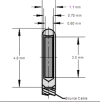Dosimetric characterization of the M-15 high-dose-rate Iridium-192 brachytherapy source using the AAPM and ESTRO formalism
- PMID: 26103489
- PMCID: PMC5690138
- DOI: 10.1120/jacmp.v16i3.5270
Dosimetric characterization of the M-15 high-dose-rate Iridium-192 brachytherapy source using the AAPM and ESTRO formalism
Abstract
The Source Production & Equipment Co. (SPEC) model M-15 is a new Iridium-192 brachytherapy source model intended for use as a temporary high-dose-rate (HDR) brachytherapy source for the Nucletron microSelectron Classic afterloading system. The purpose of this study is to characterize this HDR source for clinical application by obtaining a complete set of Monte Carlo calculated dosimetric parameters for the M-15, as recommended by AAPM and ESTRO, for isotopes with average energies greater than 50 keV. This was accomplished by using the MCNP6 Monte Carlo code to simulate the resulting source dosimetry at various points within a pseudoinfinite water phantom. These dosimetric values next were converted into the AAPM and ESTRO dosimetry parameters and the respective statistical uncertainty in each parameter also calculated and presented. The M-15 source was modeled in an MCNP6 Monte Carlo environment using the physical source specifications provided by the manufacturer. Iridium-192 photons were uniformly generated inside the iridium core of the model M-15 with photon and secondary electron transport replicated using photoatomic cross-sectional tables supplied with MCNP6. Simulations were performed for both water and air/vacuum computer models with a total of 4 × 109 sources photon history for each simulation and the in-air photon spectrum filtered to remove low-energy photons belowδ = 10 keV. Dosimetric data, including D·(r,θ), gL(r), F(r,θ), φan(r), and φ-an, and their statistical uncertainty were calculated from the output of an MCNP model consisting of an M-15 source placed at the center of a spherical water phantom of 100 cm diameter. The air kerma strength in free space, SK, and dose rate constant, Λ, also was computed from a MCNP model with M-15 Iridium-192 source, was centered at the origin of an evacuated phantom in which a critical volume containing air at STP was added 100 cm from the source center. The reference dose rate, D·(r0,θ0) ≡ D· (1cm,π/2), is found to be 4.038 ± 0.064 cGy mCi-1 h-1. The air kerma strength, SK, is reported to be 3.632 ± 0.086 cGy cm2 mCi-1 g-1, and the dose rate constant, Λ, is calculated to be 1.112 ± 0.029 cGy h-1 U-1. The normalized dose rate, radial dose function, and anisotropy function with their uncertainties were computed and are represented in both tabular and graphical format in the report. A dosimetric study was performed of the new M-15 Iridium-192 HDR brachytherapy source using the MCNP6 radiation transport code. Dosimetric parameters, including the dose-rate constant, radial dose function, and anisotropy function, were calculated in accordance with the updated AAPM and ESTRO dosimetric parameters for brachytherapy sources of average energy greater than 50 keV. These data therefore may be applied toward the development of a treatment planning program and for clinical use of the source.
Figures




Similar articles
-
Dosimetric characterization of the GammaClip™ 169Yb low dose rate permanent implant brachytherapy source for the treatment of nonsmall cell lung cancer postwedge resection.Med Phys. 2013 Aug;40(8):080701. doi: 10.1118/1.4812675. Med Phys. 2013. PMID: 23927294 Free PMC article.
-
Monte Carlo characterization of the M-19 high dose rate Iridium-192 brachytherapy source.Med Phys. 2007 Jun;34(6):1999-2006. doi: 10.1118/1.2733809. Med Phys. 2007. PMID: 17654903
-
Monte Carlo dosimetric parameter study of a new (32)P brachytherapy source.Br J Radiol. 2016 Jun;89(1062):20150783. doi: 10.1259/bjr.20150783. Epub 2016 Apr 4. Br J Radiol. 2016. PMID: 27042802 Free PMC article.
-
A Monte Carlo investigation of the dose distribution for 60Co high dose rate brachytherapy source in water and in different media.Appl Radiat Isot. 2018 Jun;136:104-110. doi: 10.1016/j.apradiso.2018.02.016. Epub 2018 Feb 18. Appl Radiat Isot. 2018. PMID: 29494942 Review.
-
End-to-end dosimetric audit: A novel procedure developed for Irish HDR brachytherapy centres.Phys Med. 2020 Dec;80:221-229. doi: 10.1016/j.ejmp.2020.10.005. Epub 2020 Nov 13. Phys Med. 2020. PMID: 33190078 Review.
References
-
- Hammer J, Seewald DH, Track C, Zoidl JP, Labeck W. Breast cancer: primary treatment with external‐beam radiation therapy and high‐dose‐rate iridium implantation. Radiology. 1994;193(2):573–77. - PubMed
-
- Kapp KS, Stuecklschweiger GF, Kapp DS, Poschauko J, Pickel H, Hackl A. Carcinoma of the cervix: analysis of complications after primary external beam radiation and Ir‐192 HDR brachytherapy. Radiother Oncol. 1997;42(2):143–53. - PubMed
-
- Kapp KS, Stuecklschweiger GF, Kapp DS, et al. Prognostic factors in patients with carcinoma of the uterine cervix treated with external beam irradiation and IR‐192 high‐dose‐rate brachytherapy. Int J Radiat Oncol Biol Phys. 1998;42(3):531–40. - PubMed
-
- Nag S. High dose rate brachytherapy: its clinical applications and treatment guidelines. Technol Cancer Res Treat. 2004;3(3):269–87. - PubMed
-
- Schmidt‐Ullrich R, Zwicker RD, Wu A, Kelly K. Interstitial IR‐192 implants of the oral cavity: the planning and construction of volume implants. Int J Radiat Oncol Biol Phys. 1991;20(5):1079–85. - PubMed
Publication types
MeSH terms
Substances
LinkOut - more resources
Full Text Sources
Other Literature Sources
Research Materials
Miscellaneous

